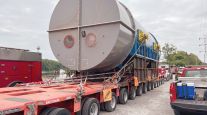Flatbed Companies Offer Drivers Incentives, Focus on Training to Keep Cargo Secure
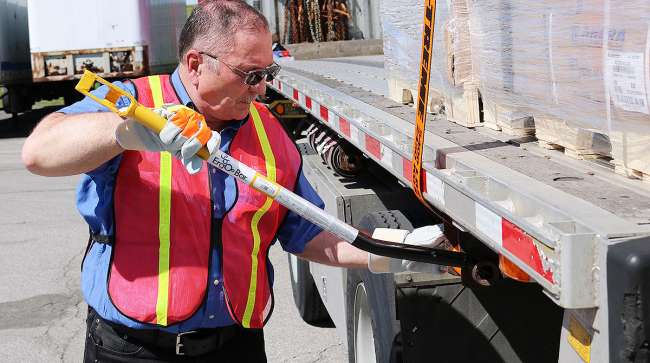
Flatbed carriers haul a wide variety of cargo, but securing that cargo requires extra work from drivers. To attract and retain those drivers, flatbed companies said they’re offering incentives and investing heavily in equipment and training to ensure loads are properly secured.
“Any time you have the exposure on a flatbed versus a [dry] van, you’re always going to have a greater chance to have a mishap,” said Craig Stanley, co-CEO of flatbed carrier Tennessee Steel Haulers, a Daseke company based in Nashville. “If a driver doesn’t do the right thing, that is exposing you even more to greater risk.”
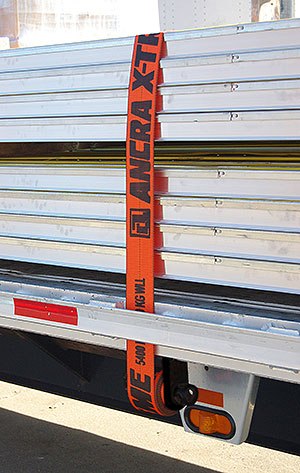
The Federal Motor Carrier Safety Administration outlines cargo securement rules. Violations can affect a fleet's safety scores in its Compliance, Safety, Accountability program. (Ancra)
Tennessee Steel Haulers has a three-day orientation for drivers. “We have trailers set up with multiple types of freight we haul, and we have a class,” Stanley said. “We make the owner-operator show us they can secure that load properly,” he said. “Steel coils are basically standing up. That is a tough one.”
Susan Kirkpatrick, chief financial officer of Buddy Moore Trucking, based in Birmingham, Ala., said there is a science behind cargo securement, and the carrier provides training identifying how different types of cargo — including steel coils — need to be secured. “A steel coil may need five or six chains on it,” she said.
Formulations for cargo securement have to do with lateral movement, said Jeff Luick, Northeast account executive for Kinedyne, a manufacturer of cargo securement equipment. Luick provides training to Kinedyne customers. “When we describe gravity and inertia, and that it has to do with their safety and the public’s safety, it really helps convince the drivers that this is something worth taking another look at and learning the proper regulations,” he said.
The Department of Transportation’s Federal Motor Carrier Safety Administration outlines cargo securement rules, and violations can impact a fleet’s safety scores in FMCSA’s Compliance, Safety, Accountability program. The agency’s regulations require carriers to use cargo securement devices to prevent articles from shifting on or within or falling from commercial motor vehicles. The agency established performance requirements concerning deceleration in the forward direction and acceleration in the rearward and lateral directions that cargo securement systems must withstand.
During training, Luick focuses on those specific regulations. “We’ve seen throughout the years that most drivers are trained by another driver, so if that initial driver doesn’t have the exact regulation and how it is applied, he is just passing on what he knows to the next driver,” he said. “A lot of times we find there will be gaps in that information, or it may not be quite correct, which could potentially cause a violation or a safety issue.”

A winch bar that is designed to make it easier for drivers to tighten straps and chains. (Kinedyne)
Barnhart Transportation, which has utilized Luick’s training, recently hauled a large piece of equipment that was 31 feet long, 21 feet wide and 12 feet high. “The center of gravity was off, so it had to be supported further on one side than the other due to the center of gravity,” said Kirt Johnson, heavy-haul operations manager for the carrier, based in Harborcreek, Pa.
Because securing loads creates more work for flatbed drivers, Buddy Moore Trucking pays flatbed drivers a percentage rather than by mileage, which turns out to be slightly higher pay per mile, Kirkpatrick said.
The carrier also offers additional compensation to drivers who do the extra work of placing tarps on a load, even if the shipper isn’t reimbursing the expense. “You have to get the tarp on the trailer then up on top of whatever you’re tarping,” she said.
Stanley said Tennessee Steel Haulers passes along tarp pay when it is paid by shippers, and added that during spring and summer shippers stepped up to the plate with increased rates. “They know the higher paying freight usually wins,” he said. “A lot of people have seen this capacity crunch we’re in and are doing something about it.”
There are several different sizes of tarps, and Buddy Moore Trucking uses 6-foot drop tarps as opposed to 8-foot tarps, which are heavier. “That might exclude us from being able to carry a load, but it is easier for our drivers,” Kirkpatrick said.
Tony White, national director of sales for Ancra Cargo, a manufacturer of cargo securement equipment, said that securing and tarping loads in all types of weather “is very demanding work. Providing drivers with the proper tools is vital for their safety and efficiency.”
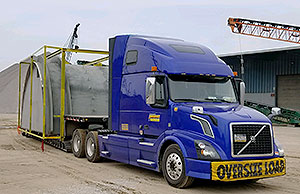
Barnhart Transportation invests in training so drivers can properly secure loads, such as this oversize load it carried from the Port of Erie in Pennsylvania. (Barnhart Transportation)
Ancra manufactures straps and winches, tie downs and chain assemblies and a tiedown calculator via a free phone app and on-site training. “Improperly secured cargo can create unsafe situations,” White said. “Not only by cargo falling from trailers, but also loads shifting and possibly causing a rollover.”
SafeTarp offers stationary equipment for tarping loads in less than 10 minutes without either the shipper or driver ever having to leave the ground, said James Lawrence, co-founder of the St. Augustine, Fla.-based company. “Some of these tarps can weigh 75 pounds, so then they have to lug them off of their trailer and tug them over the load,” Lawrence said. “It is a pretty laborious operation, actually.”
What’s more, making tarping easier is getting more important as drivers age, Lawrence said.
The majority of cargo securement equipment, such as straps, winches and chains, is carried on the truck. Buddy Moore Trucking invests about $1,800 per truck in load securement equipment, Kirkpatrick said.
Barnhart Transportation’s Johnson said he emphasizes that every binder and strap drivers carry is only good to a certain rating, so drivers have to make sure they have enough straps on the loads and ensure they properly join straps or chains together.
Kinedyne’s Luick said some products are easier to use than others. Winch straps, for example, are lighter than a chain and simpler to handle, but some loads require a chain. “On oversize loads, you’ll use a heavier chain,” he said.
Kinedyne has released a winch strap with a load limit of 6,670 pounds, which is the same as a chain. Traditional winch straps have a limit of 4,500 pounds, Luick said. Winch bars can make it easier for drivers to tighten a load. “It is more ergonomic for the drivers to use without actually hurting themselves,” he added.
Once loads are secured, fleets said they encourage drivers to stop frequently to check the load. “We’ll have guys stop 50 miles down the road to check securement. If they haven’t secured it properly, they’ll feel that early in the trip,” Kirkpatrick said.
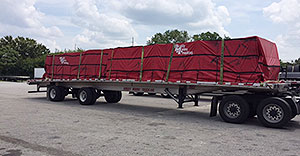
Buddy Moore Trucking offers additional pay to drivers who do the extra work of placing tarps on a load, even if shippers don't reimburse this expense. (Buddy Moore Trucking)
At Tennessee Steel Haulers, drivers are encouraged to stop every few hours to check the load, and every time drivers pull into one of TSH’s terminals, they travel through a safety lane. “We make sure their tires are well inflated and check out the securement of the cargo,” Stanley said.
Steven Skinner, president of Skinner Transfer Corp., a carrier based in Reedsburg, Wis., and co-founder of Cargo Strategies, which manufacturers cargo securement equipment, noted that roadside enforcement officers are focused on cargo securement. “They really don’t differentiate between whether cargo is in a flatbed or on a dry van. They still require trucking companies to secure properly,” Skinner said.
In addition to ensuring regulatory compliance, securing loads increases driver safety. Some workers’ compensation claims “are simply from drivers having cargo shift and fall on them,” Skinner said, adding that cargo that has shifted can fall on drivers or drivers can hurt themselves picking up and re-stacking fallen cargo.
Skinner and Cargo Strategies co-owner Mike Stromberg developed a patented hook that works with existing logistics straps used in a dry van trailer to secure pallets. “It was specifically designed for uneven, odd-sized freight,” Skinner said. Stromberg added that having the best tools for drivers can aid in driver retention. To attract those drivers, Tennessee Steel Haulers has lease-purchase programs for Class 8 tractors and flatbed trailers. “We feel like that has been a good system for us for recruiting and retaining,” Stanley said.
And programs like this can only help the sector, which — like all of trucking — is “clamoring for drivers,” Buddy Moore’s Kirkpatrick said.
Along with these advancements, there is also consistency to the work, said Jerry Squyres, vice president of sales and marketing for B2B Supply, based in Dallas. He noted that many of the tools drivers rely on to keep cargo secure have remained consistent over the years. “They still use tie-down straps and bars,” he said.


